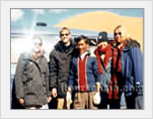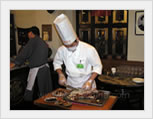
Mongolian Singing and Dancing Guide
-Travel to Mongolian Singing and Dancing The songs and dances of Mongolian, which are often performed with the accompaniment of uniquely Mongolian instruments such as the morin khuur and tovshuur, are easily distinguishable from music from anywhere else in the world. The songs and dances of the Burial and Durvud ethnic groups are especially distinctive. While dancing the "Biyelgee " dance, particularly in western Mongolia, dancers use the upper part of their bodies to express their identity in respect to their sex, tribe or ethnic group. Originally, this dance was performed at festivals in herders' tents, in ceremonies by local dignitaries and in monasteries.
The songs and dances of Mongolian, which are often performed with the accompaniment of uniquely Mongolian instruments such as the morin khuur and tovshuur, are easily distinguishable from music from anywhere else in the world. The songs and dances of the Burial and Durvud ethnic groups are especially distinctive. While dancing the "Biyelgee " dance, particularly in western Mongolia, dancers use the upper part of their bodies to express their identity in respect to their sex, tribe or ethnic group. Originally, this dance was performed at festivals in herders' tents, in ceremonies by local dignitaries and in monasteries.
 The ancient religious mask dance "Tsam" is one of the most significant religious rituals reflecting Buddhist teaching. The custom of celebrating Tsam was introduced into Mongolia in the 16th century from Tibet. In Mongolia Tsam was enriched with elements of witchcraft and the pagan traditions of the nomads. The Mongolian Tsam costumes and masks, as well as stage sets, differ considerably from those used elsewhere. They contrast sharply in colour in accordance with local tastes; Mongolian masks tend towards bold primary colours - red, black, yellow, white and blue - and look more expressive than those used in other countries. Dances imitating the gait of a horse, such as the Jonon Khar and JamalKhar are very popular amongst the Western Mongols - the Durvuds, the Bayads, the Torguuds, the Khotons and the Zakhchins. Each tribe, however, performs these dances in its own way.
The ancient religious mask dance "Tsam" is one of the most significant religious rituals reflecting Buddhist teaching. The custom of celebrating Tsam was introduced into Mongolia in the 16th century from Tibet. In Mongolia Tsam was enriched with elements of witchcraft and the pagan traditions of the nomads. The Mongolian Tsam costumes and masks, as well as stage sets, differ considerably from those used elsewhere. They contrast sharply in colour in accordance with local tastes; Mongolian masks tend towards bold primary colours - red, black, yellow, white and blue - and look more expressive than those used in other countries. Dances imitating the gait of a horse, such as the Jonon Khar and JamalKhar are very popular amongst the Western Mongols - the Durvuds, the Bayads, the Torguuds, the Khotons and the Zakhchins. Each tribe, however, performs these dances in its own way.
The ability to dance without using one's feet at all is the mark of true skill in the Mongolian dancing. One popular dance is performed with cups full of water. The dance must be performed whilst balancing the cup and without spilling a single drop. The dance varies with whether the cups are balanced on the head, on the hand or on the knees. The extraordinary flexibility of the dancers, the musical accompaniment and the colours of the costumes worn all serve to distinguish each dance. In considering the dances, it should be remembered that the traditional manner of performing "Biyelgee" and other dances derives from the handing down of techniques and styles from generation to generation in an oral tradition eventually reaching us in a somewhat modified form from the original.
More Attractions in Inner Mongolia
- Resonant Sand Bay
- Wudangzhao
- Inner Mongolian Museum
- Tomb of Genghis Khan
- Zhaojun Tomb of Hohhot
- Mongolia Yurts
- Meidaizhao
- Five Pagoda Temple
- Dazhao Lamasery
- Mongolian Lamb Dinner
- Mongolian Singing and Dancing
- Wrestling and Archery
- Grassland and Pastures
- Hulun Lake
- Ergun River
- Bayan Huxu Grassland
- Xilamuren Grassland
- Ordos Museum
- Bashang Grasslands
- Kubuqi Desert
- Hailar National Forest Park
Your Question & Quick Answer*We welcome and appreciate your questions & reviews
Booking Procedures | Terms & Conditions | Payment Methods | Links | Site Map | About Us | Contact Us | Travel Agent
Copyright 2008, All rights reserved.. itourbeijing.com professional china travel guide and china travel service
TEL: 86-10-85711972 (Universal) 1-888-288-9328 (North America) E-mail: contact@itourbeijng.com
Tours Index | China Tours | Beijing Tours | Xi'an Tours | Shanghai Tours | Guilin Tours | Tibet Tours
China Travel | Beijing Travel | Shanghai Travel | Xi'an Travel | Guilin Travel |Beijing Map
China Golf | Beijing Golf | Shanghai Golf | Xiamen Golf | The Great Wall Travel | Yangtze Cruise | Travel Picture



